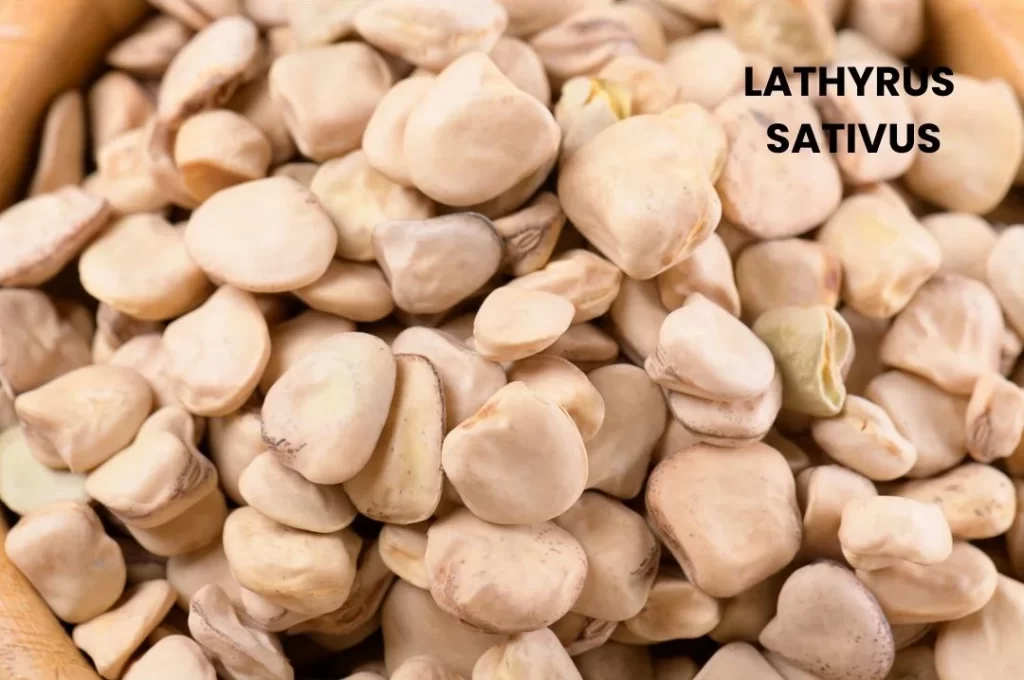Lathyrus Sativus, commonly known as chick-pea, is a homeopathic remedy that primarily affects the nervous system, especially the spinal cord.
It is used for various neurological and paralytic conditions, with a special focus on the lower extremities.
This remedy is particularly beneficial for conditions that involve spastic paralysis, lateral sclerosis, and other forms of muscular and nerve debility.

SOURCE INFORMATION
- Common Name: Chick-pea
- Scientific Name: Lathyrus sativus
Scientific Classification
- Family: Fabaceae
- Genus: Lathyrus
- Species: Lathyrus sativus
Origin and Historical Facts
- The chick-pea plant is native to the Mediterranean region and parts of Asia.
- Historically, Lathyrus sativus has been recognized for its nutritional value and its role in food security during famines.
- However, its seeds contain a neurotoxin that can cause a condition known as lathyrism, which affects the nervous system.
- This property is harnessed in homeopathy to treat various neurological disorders.
KEY CHARACTERISTICS
- Affects Spinal Cord: Specifically targets the lateral and anterior columns of the spinal cord.
- Increased Reflexes: Reflexes are heightened, which can lead to spastic conditions.
- Paralytic Affections: Especially in the lower extremities, causing spastic paralysis and related conditions.
- No Pain: Symptoms are not typically associated with pain.
- Post-Influenza and Exhaustive Diseases: Useful in conditions following influenza or other debilitating illnesses that result in weakness and slow recovery of nerve power.
- Constant Yawning: Indicative of underlying neurological exhaustion.
DETAILED ORGAN SYMPTOMS
MIND
- Depression: Feelings of sadness and hypochondriacal tendencies.
- Vertigo: Dizziness, especially when standing with eyes closed.
MOUTH
- Burning Pain: Sensation of burning at the tip of the tongue.
- Tingling and Numbness: Tongue and lips feel numb and tingly, as if scalded.
EXTREMITIES
- Numbness: Tips of fingers feel numb.
- Gait Issues: Tremulous and tottering gait, excessive rigidity of legs leading to a spastic walk.
- Knee Problems: Knees knock together when walking.
- Leg Cramps: Worsened by cold and accompanied by cold feet.
- Paralysis: Involves the lower limbs, with symptoms of stiffness and lameness in ankles and knees. Patients have difficulty extending or crossing their legs when sitting.
- Muscle Wasting: Particularly affects the gluteal muscles and lower limbs, which may appear blue and swollen if legs hang down.
- Toe and Heel Issues: Toes do not leave the floor and heels do not touch the floor while walking, indicating severe spasticity.
- Posture Problems: Patients sit bent forward and have difficulty straightening up.
URINE
- Bladder Reflex: Increased reflex leading to frequent urination and urgency, sometimes resulting in involuntary urination.
RELATIONSHIP WITH OTHER DRUGS
Compare with
- Oxytropis: Known for its paralytic symptoms and neurological effects.
- SECALE CORNUTUMSecale: Used for conditions involving gangrene, spasms, and coldness.
- Petiveria: South American plant used for paralysis and paraplegia with numbness and a sensation of internal coldness.
- Agrostemma githago (Corn-cockle): Known for burning sensations in the stomach, esophagus, lower abdomen, and anus, along with nausea, vomiting, impaired locomotion, and vertigo.
DOSE
- Potency: Third potency is commonly used.
Frequently Asked Questions (FAQs)
What conditions is Lathyrus Sativus used for in homeopathy?
- Lathyrus Sativus is primarily used for neurological and paralytic conditions, especially those affecting the lower extremities, such as spastic paralysis, lateral sclerosis, and post-influenza debility.
How does Lathyrus Sativus affect the nervous system?
- It targets the lateral and anterior columns of the spinal cord, leading to increased reflexes and spastic conditions without causing pain.
Can Lathyrus Sativus be used for urinary issues?
- Yes, it can help with increased bladder reflex, leading to frequent urination and urgency.
What are the key symptoms indicating the use of Lathyrus Sativus?
- Key symptoms include spastic paralysis, numbness in fingers, tremulous gait, knee problems, muscle wasting, and urinary urgency.
How is Lathyrus Sativus administered?
- Lathyrus Sativus is administered in the third potency.
Glossary of Difficult Words
- Lateral Sclerosis: A condition affecting the lateral columns of the spinal cord, leading to muscle weakness and spasticity.
- Athetosis: A condition characterized by involuntary writhing movements, typically of the hands and feet.
- Myelitis: Inflammation of the spinal cord.
- Hypochondriacal: Excessive worry about having a serious illness.
- Cramps: Sudden, involuntary muscle contractions causing pain.
- Spasticity: A condition where muscles are continuously contracted, causing stiffness and tightness.
- Paraplegia: Paralysis affecting the lower half of the body.
- Neurotoxin: A toxin that affects the nervous system.
- Lathyrism: A neurological disease caused by consuming large amounts of Lathyrus sativus seeds, characterized by paralysis and muscle wasting.
